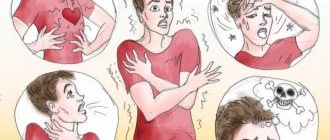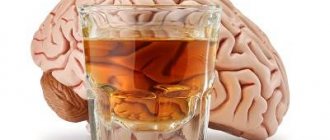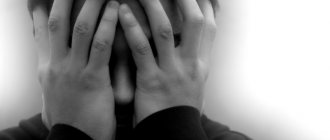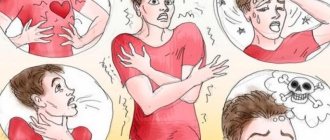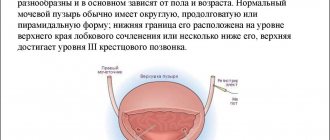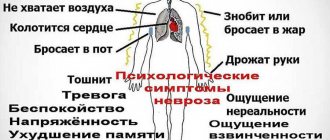What can trigger panic attacks during VSD?
Depersonalization in VSD manifests itself due to dysfunctions of the nervous system and brain. With VSD, panic attacks are not a rare occurrence. To cope with anxiety disorders and panic attacks that accompany psychovegetative syndrome, you need to understand what vegetative-vascular dystonia with panic attacks actually is.
Having understood the reasons for where fears come from during VSD, it will be easier to cope with and fight them. Attacks are provoked by emotional or mental stress, and it can be anything:
- headache;
- stressful situations;
- chronic fatigue and overstrain;
- unhealthy sleep;
- personal characteristics, for example, increased suspiciousness;
- pathologies in relatives;
- development of cervical osteochondrosis.
All these factors can be the reasons for the development of panic attacks and VSD, although many people who have survived attacks claim that this condition happens out of the blue.
Neurosis, panic attacks. Life after deliverance | FDRK
The success of healing from panic attacks directly depends on eliminating the root cause of their occurrence.
It is clear that in order to fully understand how to get rid of panic attacks, neurosis and VSD, it takes time, and fears do not go away in one day. First the tension goes away, followed by agoraphobia.
Let us return again to the experience of a person who managed to overcome his anxiety disorders. When he had health problems, in addition to nervousness, agoraphobia manifested itself very strongly.
In those rare moments when he was going to leave the house, he always took pills with him, as he was constantly haunted by the thought: “What if I get sick?” It seemed to him that every exit from the house would now be accompanied by similar thoughts and fears.
But later it turned out that this was not so. As soon as he gradually began to get rid of panic attacks and other anxious manifestations, these thoughts also began to disappear from him.
It's hard to believe
Many people who are overcome by neurosis, panic attacks and VSD are interested in how they will feel after the problem disappears. And won't she come back again? Therefore, we decided to devote a separate article to this topic.
When a person is just starting treatment for panic attacks and other psychological problems, he needs to understand that he should not expect quick results. For these problems in his life did not appear in one day and, perhaps, not in one year, and therefore they do not go away immediately.
He must adjust himself to the fact that it takes time to completely get rid of neurosis and panic attacks. Fears will go away gradually.
First, tension goes away, agoraphobia decreases and disappears (when a person is afraid of open doors, open space, he develops a fear of crowds of people).
Signs of panic attacks
In order to understand whether it’s time to sound the alarm about panic attacks or whether it’s just stress, you need to find out how a panic attack usually manifests itself during VSD.
So, almost everyone describes this unpleasant phenomenon as “increasing anxiety, a feeling of unreality, a state of panic, fear of death, all things fade into the background.” VSD and fears are closely related. There have been cases when people who suffered panic attacks even called an ambulance because they were unable to cope with the attack on their own. Most often, the need to call an ambulance is provoked by symptoms such as increased heart rate, pronounced tachycardia, and pain in the chest area. A feeling of suffocation and crippling fear, which can also cause an attack of nausea. Probably everyone has noticed that very often, if a person becomes scared, he begins to vomit. Blood pressure rises and patients, in an attack of panic, are constantly forced to measure it.
A panic attack lasts from fifteen minutes to an hour and a half. Of course, it doesn’t seem like much, but in this state, every minute can seem like an eternity. Although, of course, attacks during VSD differ in strength and length. For example, it can really be an enveloping fear, but sometimes patients can simply fall into a state of despondency and depression due to a feeling of growing anxiety inside. Panic attacks are not dangerous in themselves, but they can turn the patient’s life upside down, and this is no wonder. Patients try to avoid situations in which they were once overtaken by this illness; they become nervous and irritable, fearing a recurrence of the symptoms of a panic attack. And, as you know, stress can only provoke attacks. Vegetative-vascular dystonia with panic attacks can ruin your usual way of life. And it turns out to be a vicious circle that can be broken, because getting rid of VSD is not an impossible task.
Chapter Six Treatment of vegetative-vascular dystonia
Now that we have figured out who it is, this vegetative-vascular dystonia, it would not hurt us to find out exactly how to deal with it. In fact, this devil is not as terrible as he paints himself, but in order to put himself in order after such art of his, it will take some effort.
Our tasks here essentially boil down to two things: on the one hand, we must calm our nerves, that is, get rid of the feeling of fear, anxiety and internal tension; on the other hand, we need to normalize the functioning of the autonomic nervous system, in particular, get rid of unnecessary autonomic conditioned reflexes.
Types of panic attacks with VSD
The following types of panic attacks can be distinguished based on their causes:
- Spontaneous, which manifests itself in the most unexpected way.
- Situational, which manifests itself due to a specific situation that has a negative impact on the general condition of a person.
- A conditioned situational panic attack occurs when exposed to a biological or chemical stimulus, for example, when drinking alcohol.
Also, panic attacks during VSD can be distinguished by the type of VSD in which they occur:
- A panic attack during VSD of the hypertensive type is characterized by symptoms such as increased blood pressure and rapid pulse.
- Panic attack with VSD of the hypotonic type - decreased blood pressure, weakness, shortness of breath, nausea, increased sweating.
- A panic attack with VSD is of a mixed type - the patient can experience both types of panic attacks.
A better understanding of the problem allows you to treat it not as something unknown and, accordingly, panic less.
Treatment of VSD and panic attacks
To cure VSD with panic attacks, doctors offer a huge number of psychological therapy methods, each of which is selected by qualified specialists individually for each patient. Another option for solving the problem could be taking tranquilizers, but, of course, most people are afraid of this method, for the reasons that tranquilizers cause a feeling of lethargy and withdrawal from reality. But here, as in any case, the psychotherapist must control the entire process and, correctly selected medications will not in any way affect the usual way of life. In the same case, if all of the above still does not help, the scales fall on the side of potent drugs.
How to cure VSD on your own
And yet, taking strong drugs and going to a psychotherapist is a difficult step, and therefore many people wonder how to cure VSD on their own. Any patient suffering from VSD and anxiety disorders should have in their arsenal such medicinal herbs as chamomile, motherwort, and birch leaves. Valerian can also calm a person's raging consciousness.
If a panic attack has already overtaken a person, then it should be noted that it is simply impossible to relieve the attack and get rid of the symptoms that cause discomfort immediately. In principle, a panic attack itself goes away in an average of 30-40 minutes; this phenomenon is not long-term. Of course, to advise simply waiting until the attack disappears on its own would be cruel, to say the least. Psychologists recommend some techniques on how to deal with an attack and how to get rid of unpleasant sensations as soon as possible:
- If you can get further away from the situation or place that caused the attack, then immediately get up and leave. Shock therapy does not work here and you should not try to “face your fear face to face”; you need to get rid of unpleasant sensations immediately.
- Focus on breathing. Count your inhalations and exhalations; if it seems like you can’t breathe, then you need to take any bag and breathe into it as calmly as possible.
- Move the vector of attention to something abstract. For example, count steps, chairs, or anything that comes into view.
- Smile. Stretch your lips in a smile, as if creating a mood for your body.
Following these simple tricks will help ease a panic attack and even learn how to manage it.
Andrey Kurpatov - 4 terrible secrets. Panic attack and cardiac neurosis
6 …
Vegetation is sick...
If we have more or less understood the concept of “vegetatives” (i.e., the autonomic nervous system), it’s time to understand what “dystonia” means. This term sounds threatening, although in reality we are talking about nothing more than a simple change (“dys-”) in the tone of the autonomic nervous system or, more precisely, about malfunctions in its functioning. Such a failure in itself is not a tragedy, because a failure is not a breakdown. If your watch has gone wrong and is now showing the wrong time, this does not mean that it is broken. Perhaps you simply forgot to start them or insert a new battery, so let's not panic ahead of time. Although, of course, when the clock fails and when the autonomic nervous system malfunctions, we naturally have problems. But, really, a failure is not a disaster, it is a difficulty and a surmountable difficulty.
We will talk about “dystonia” and the elimination of this “failure” throughout this book. But now I would like to talk about what kind of diseases of the autonomic nervous system there are, and it, like any organ of our body, can get sick. Autonomic disorders can be caused by a variety of reasons.
Firstly , since the autonomic nervous system is part of the nervous system, then, accordingly, neurological diseases (diseases of the brain and nerves) can also manifest themselves as the so-called “autonomic failure syndrome.” Most often, vegetative suffering in this case is caused by the consequences of a neuroinfection, severe brain injury, or, for example, it may be a consequence of alcoholism, in which the nervous tissue suffers in the most merciless way. Of course, in this case, the occurrence of autonomic disorders (palpitations, fluctuations in blood pressure, dizziness, fainting, sweating, etc.) will be associated in time and circumstances with the corresponding diseases - severe infection (for example, influenza), traumatic brain injury and etc.
Secondly , sometimes the cause of autonomic disorders is other bodily ailments. Disease of the thyroid gland, manifested by thyrotoxicosis, pathology of the adrenal glands and other diseases, during which the body organs related to the endocrine system of the body suffer, involve the autonomic nervous system in the disease. In addition, any severe somatic pathology (including infectious diseases), leading the body to exhaustion, can lead to one or another autonomic disorder.
Thirdly , the cause of autonomic disorders can be mental illness itself. Both severe anxiety disorders and depression often lead to changes in the functioning of the autonomic nervous system. They either cause a kind of “vegetative storm”, or are limited to only a slight “vegetative storm”, since, as we already know, not a single human emotion exists without a “vegetative component”.
Autonomic disorders
…
Certain signs of autonomic disorders can indeed be caused by unimaginable diseases. However, in this case they, as a rule, stand in the background (that is, they do not come to the forefront of painful symptoms); have an obvious organic substrate (that is, their cause lies on the surface and doctors simply cannot trace it); in addition, they are associated with these diseases by the “time and place” of their appearance. For vegetative disorders of a psychological nature, everything is different - they come to the fore (i.e., they worry us more than anything else), there is no organic pathology (i.e., doctors cannot find a bodily pathology that would explain our ailment), and the appearance of symptoms vegetative malaise in this case is associated with stress in “time and place”.
However, most often our autonomic nervous system suffers for purely psychological reasons. In this case, we are talking about so-called “somatoform autonomic dysfunctions” (I apologize for this untranslatable medical folklore). When our psychological reactions turn (through disruption of the autonomic nervous system) into bodily reactions, we develop specific symptoms of a particular ailment. In some cases, a malfunction of the autonomic nervous system affects mainly the cardiovascular system, in another – the stomach and intestines, in a third – the respiratory system, etc. And this is precisely a malfunction in regulation, and not a disease of these organs, although many representatives “Homo sapiens” species, without the relevant information, begin to think differently.
In fact, in this case, doctors make a “fatal” diagnosis for the patient of vegetative-vascular dystonia. Which, as it turns out, has the most mediocre relation to the heart and blood vessels, and the problem is only in the regulation of their activity. By the way, they can, in principle, get along quite well without this regulation. But failures in this regulation cause more trouble than actual problems.
Chapter two Diagnosis of vegetative-vascular dystonia
There is terrible confusion with the diagnosis of “vegetative-vascular dystonia”. And everyone who received this diagnosis probably knows about the existence of this confusion. However, it is characteristic only of domestic medicine, in which until recently there was no psychology at all, and if there was, it was only “Soviet psychology” (where the “social” is always higher than the “personal”), which can hardly be called psychology.
In the West, where real scientific study of psychology has been carried out for almost a hundred years, there is no trace of this confusion. Therefore, anyone who goes to see a doctor with symptoms of vegetative-vascular dystonia is immediately sent to a psychotherapist, and does not go from doctor to doctor like a damn person for 7–9 years (this is the average period of ordeal for a Russian suffering from VSD, from his first visit to a doctor to a visit to a psychotherapist ).
I guess that this is of little interest to non-specialists, but I still consider it necessary to talk about this confusion, since in reality (hold on to your chair!) such a disease as vegetative-vascular dystonia does not exist in nature. There is a diagnosis, but there is no disease, at least “heart disease”. However, this does not mean that there is no problem... Confused? Please forgive me, I didn’t mean to, I’ll try to clarify now.
And how well it all started!..
It seems to me that it is best to start the story about vegetative-vascular dystonia with a real story. I present to you our heroine: her name is Tatyana, she is 21 years old, she is studying at St. Petersburg State University to become a lawyer. This summer day turned out to be sunny, Tatyana had just passed her exam, and therefore she was in a good mood. True, her life was somewhat overshadowed by a break with a young man, but she is a modern girl and understood that “you won’t be nice by force,” “running after men means not respecting yourself,” and “better sooner than later, if everything is inevitable anyway.” Her parents are wealthy people, so Tatyana has her own foreign car and her own apartment in the city center. Actually, that’s where our heroine was heading, sitting in splendid isolation behind the wheel of a BMW, straight along the embankment of the Fontanka River. But bad luck, the cars on the aforementioned embankment are hopelessly stuck - a traffic jam.
6 …
End of introductory passage
You can buy the book and
Read more
Want to know the price? YES I WANT TO
Prevention of panic attacks and VSD
If you follow preventive measures, then panic attacks during VSD will never bother you. Here are some tips on how to prevent attacks during psychovegetative syndrome and, in any case, feel good:
- Rejection of bad habits. Alcohol depletes the body, smoking increases the heart rate, all this causes stress in the body, which subsequently leads to an attack. No matter how trivial it may sound, you should choose mostly healthy foods, since foods high in sugar and fat can also lead to panic attacks.
- Physical activity should, for example, walk before bed, jogging, yoga, swimming pool, all this promotes deep sleep, which is also necessary in order not to provoke unpleasant attacks.
Thus, healthy sleep, giving up bad habits, proper nutrition, a little exercise - all this will help in the prevention of panic attacks with vegetative-vascular dystonia.
If you add a cup of aromatic chamomile tea to all of the above in the morning or before bed, then prevention can even become a pleasant ritual. What could be better than taking a walk before bed, breathing in some fresh air, and then, before a deep and pleasant sleep, drinking a cup of hot herbal tea. A happy life without panic attacks is a reality, a pleasant reality.
Source


